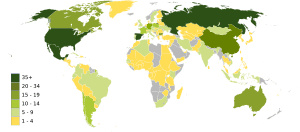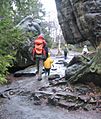Biosphere reserve facts for kids
A biosphere reserve is a special place on Earth. It has amazing plants and animals that are very important for science and nature. UNESCO (which stands for the United Nations Educational, Scientific and Cultural Organization) gives these places a special label. This helps protect them. The main goal is to manage, research, and teach about saving different ecosystems. It also means using natural resources in a smart way. For example, if people need to use fish or trees from these areas, they do it in a way that doesn't harm the environment too much.
A biosphere reserve is made up of three main parts or zones:
Contents
Understanding the Three Zones of a Biosphere Reserve
The Core Zone: Nature's Safe Space
The core zone is the most protected part. No human activity is allowed here. It's like a safe haven for plants and animals to live without disturbance. This zone is crucial for keeping nature wild and healthy.
The Buffer Zone: A Gentle Border
The buffer zone surrounds the core area. In this zone, local people can have limited access. They can gather some resources, but only in ways that don't harm the environment. This helps protect the core zone while still supporting local communities.
The Transition Zone: Where People and Nature Meet
The transition zone is the outermost part of the reserve. This area is open for people to live and gather resources. It's where communities work with the reserve managers. They find ways to live and use resources sustainably. This zone helps balance human needs with nature's protection.
The Man and the Biosphere Program
The idea of biosphere reserves comes from UNESCO's Man and the Biosphere Program (MAB). This program started in 1971. It created the World Network of Biosphere Reserves.
Sharing Knowledge for a Better Future
Biosphere reserves in this network share ideas and experiences. They learn from each other about new ways to live sustainably. These areas are like living laboratories. They test new methods for balancing human life with nature. The main goal is to create a good relationship between people and the natural world. This balance is very important for all of us.
Images for kids
-
The Bee Lick Creek, of the Jefferson Memorial Forest, was designated as a National Audubon Society wildlife refuge.
-
A forest of the Aulanko Reserve in Hämeenlinna, Tavastia Proper, Finland
-
A bridged stone river in Bistrishko Branishte, an early Bulgarian nature reserve established in 1934.
-
The Tarvasjõgi river at Põhja-Kõrvemaa Nature Reserve in Estonia
-
Nature reserve near Budapest, next to Lake Naplás
-
Peñas Blancas, part of the Bosawás Biosphere Reserve is the second largest rainforest in the Western Hemisphere, after the Amazonian Rainforest in Brazil. Located northeast of the city of Jinotega in Northeastern Nicaragua.
-
Cascade Head, Oregon, United States, is a UNESCO biosphere reserve
See also
 In Spanish: Reserva natural para niños
In Spanish: Reserva natural para niños
















